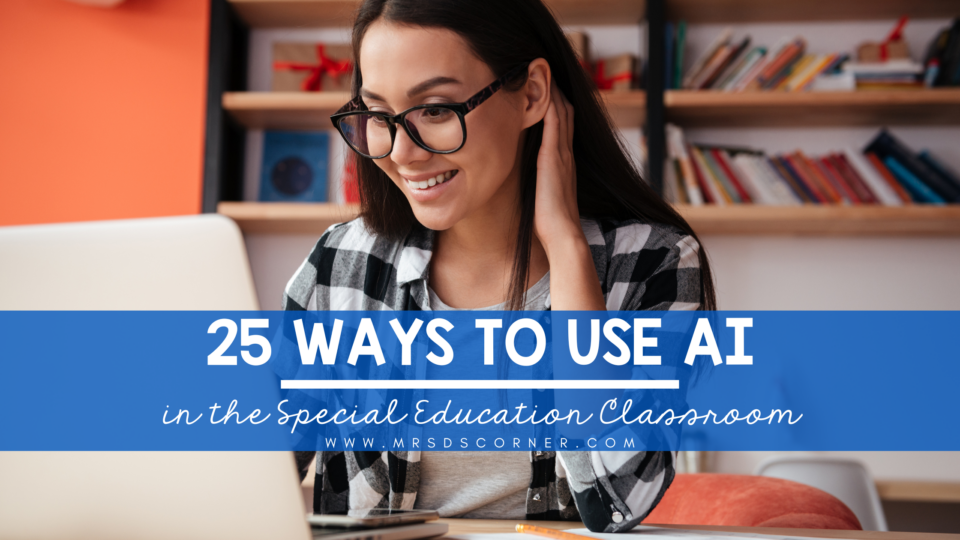Artificial Intelligence (AI) is revolutionizing the field of education, especially in special education classrooms. Teachers are using it for more and more tasks to help them save time, energy, and money. But is it all it’s cracked up to be, and can it have practical implications for your classroom?


While you may think of AI as something like ChatGPT or MagicSchool, AI has been used in special education for quite some time in different forms. Here are 25 innovative ways teachers are using AI to enhance learning experiences for students with special needs.
AI in Special Ed
Pre-Assessment Tools
If you want to test your students before teaching material to understand how much they already know, ask AI to create a pre-assessment for the topic.
Speech Recognition Tools
Speech recognition technology helps students with speech impairments communicate effectively by transcribing spoken words into text. It is also used to translate written words into speech—audiobooks, anyone?
Study Guides
Forget spending hours creating study guides for your lessons. AI can now generate one for your students based on the data you give it about the information you have taught.
Lesson Pacing Ideas
When you’re not sure how to pace out or plan your lessons, AI can generate a framework for you. Remember that you should always tailor it to your students’ needs and progress rather than what AI has suggested.
Adaptive Learning Platforms
AI-powered platforms adjust the difficulty level of assignments based on students’ progress, ensuring a challenging yet achievable learning experience. Many educational apps progress based on the student’s performance, and they’re widely used to differentiate instruction in all classrooms, not just special education.
Visual and Written Writing Prompts
Writing prompts can be time-consuming to come up with. AI has the ability to generate writing prompts that are both written and visual in nature. Keep in mind that visual AI still needs quite a bit of refinement, so previewing the prompts before sharing them with your students is an absolute must.
Automated Grading Systems
AI systems can also do automated grading. This saves teachers time and allows them to focus on providing student feedback and support.
Interactive Learning Assistants
Virtual assistants powered by AI support students with special needs by providing guidance, answering questions, and offering feedback. You can actually create or use a chatbot-type technology to assist students in real-time.
Data-Driven Decision Making
When data needs to be analyzed, put AI to work. It has the ability to analyze vast amounts of data to identify trends and patterns that inform decision-making processes when supporting students.
Natural Language Processing (NLP)
NLP technology helps students with language difficulties by breaking down complex texts into simpler language and providing explanations. It offers students texts on their level so that they can be successful.
Behavioral Intervention Tools
AI tools track student behavior patterns and provide insights to help teachers implement effective behavioral interventions. Class Dojo and other behavior modification tools are examples of this in practice.
IEP Goal Writing
There is a lot of controversy about using AI to write goals for Individualized Education Plans (IEPs), but they can be used for such tasks. The main thing to remember is that all goals should be specific, measurable, attainable, realistic, and timely. They should also be highly individualized to the student.
Lesson Ideas
Need help with how to teach a specific topic or skill? Ask AI for help!
Feedback Generation
AI generates instant feedback on student work, highlighting strengths and areas for improvement so that there is continuous learning. For example, programs like Grammarly are great for analyzing students’ written work.
Collaborative Learning Platforms
AI fosters collaboration among students with special needs through virtual platforms that help them develop communication and group work skills.
Assistive Technology Integration
AI integrates with assistive technologies like screen readers and text-to-speech tools to enhance student accessibility.
Cognitive Skills Development
AI-based programs target cognitive skills development in students with learning disabilities, improving memory, attention, and problem-solving abilities. These types of apps make it fun for students while weaving in learning.
Adaptive Scheduling Systems
AI optimizes scheduling for students with complex needs, ensuring they receive appropriate support and resources at the right times.
Parent-Teacher Communication Apps
AI-powered apps facilitate communication between teachers and parents of students with special needs, promoting collaboration and information sharing. Text generative AI is also helpful for drafting emails to parents.
Accessibility Features in Learning Materials
AI enhances the accessibility of learning materials by providing alternative formats, such as audio descriptions and tactile graphics.
Real-time Monitoring Tools
AI monitors student progress in real time, alerting teachers to any challenges or areas where additional support may be needed.
Gamification for Engagement
AI gamification elements increase student engagement by incorporating interactive games and rewards into learning activities.
Individualized Behavior Plans
AI analyzes behavior data to create individualized behavior plans for students with behavioral challenges. It can also be used to help write behavior intervention plan goals and strategies.
Professional Development Support
AI offers professional development resources and training modules tailored to educators working with students with special needs. Teachers can ask AI to generate a list of professional development topics to cover throughout a school year, and a variety of ideas will be provided. This is especially helpful if the person creating the training feeds the school’s challenges (e.g., aggressive behavior, elopement, etc.) into the AI so that it can generate ideas based on those topics.
Inclusive Curriculum Design Tools
AI can assist in providing a framework for an inclusive curriculum or lessons that address the needs of all of the students in the class.
Integrating AI in special education classrooms not only enhances learning experiences but also empowers teachers to provide personalized support and foster inclusive environments for students with special needs. It may not be perfect, but there are many ways to use it to save time, money, and energy.

